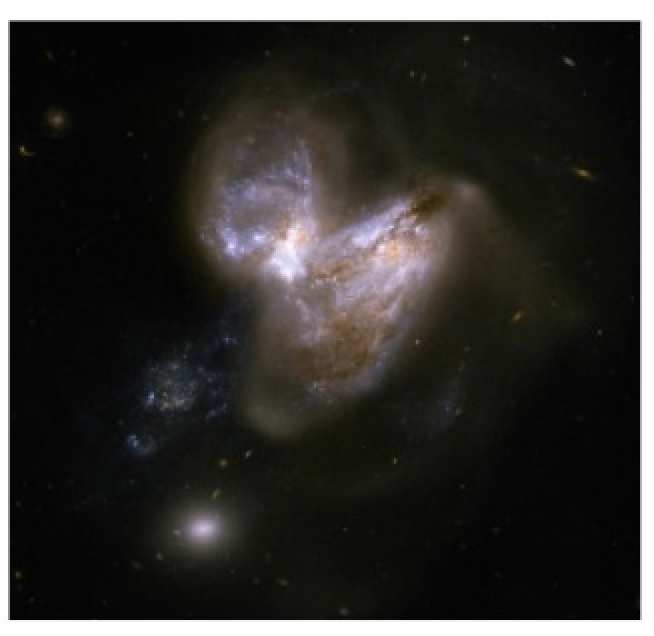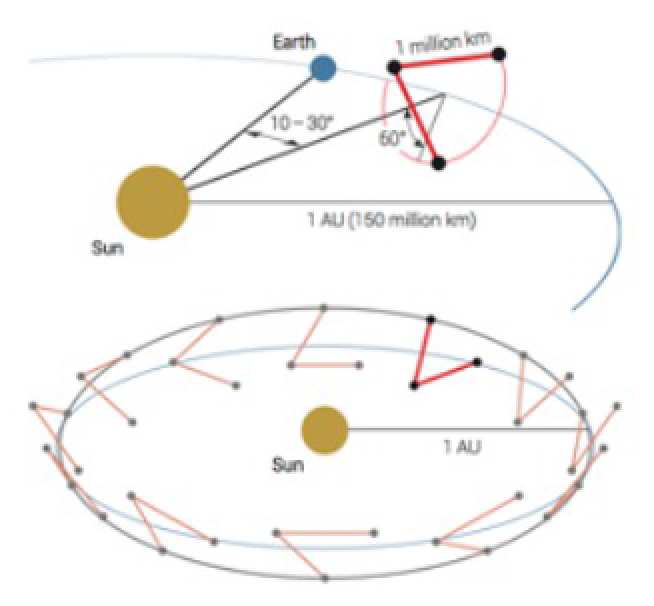eLISA
T Sumner, P Wass, D Hollington
eLISA is a mission under development as the European Space Agency’s third Large class mission in its Cosmic Vision programme. The goal is to explore the science theme ‘The Gravitational Universe’ by studying gravitational waves emitted by compact objects in the near and distant universe. Gravitational wave observations offer a new and unique means of studying our Universe and probing the intricate details of General Relativity. As well as enlarging our understanding of physics and astronomy, they offer an unprecedented opportunity to discover completely new physics unprobed by electromagnetic observatories.
The evolved Laser Interferometer Space Antenna (eLISA) is a satellite mission which will observe gravitational waves in the frequency range between 0.1mHz and 0.1Hz from a wide variety astrophysical sources. This will allow precision tests of General Relativity and a new means of doing astrophysics and cosmology.
More details about the project
The Science
Fundamental Physics:
eLISA will enable tests of General Relativity to unprecedented precision. In particular it will provide:
- A guaranteed direct detection of gravitational waves unless they propagate in a way not described by General Relativity. Stellar binary systems exist in the Milky Way which are guaranteed ‘calibration’ sources for the eLISA observatory.
- Test of propagation of gravitational waves at the speed of light
- Measurement of polarisation states of gravitational waves
- Mapping of the space-time metric around super massive black-holes by the tracing the gravitational signal generated by the inspiral of stellar mass compact objects.
- Detailed tests of numerical relativity predictions
Astrophysics:

eLISA will open up a new window on the universe for astrophysical observation:
- Population study of thousands of compact white-dwarf binary systems in the Milky Way. This will provide information about the evolution, life cycle and distribution of these systems which eventually give rise to Type Ia supernovae.
- Mergers of massive black-holes at the centres of galaxies will be observed from throughout the lifetime of the universe allowing a study of the progenitors of massive black holes, the galaxy merger history of the universe, as well as the energy loss processes associated with the merger coalescence and ringdown of SMBHs.
Cosmology:
eLISA provides an opportunity to probe a stochastic background of gravitational waves originating in TeV scale processes in the very early universe. Such a detection would revolutionise our understanding of exotic physics in the first moments after the big bang such as:
- Amplification of quantum vacuum fluctuations during inflation
- Phase transitions leading to cosmic strings bursts
The Mission

eLISA will be launched into orbit around the Sun at a distance of 1AU. Three spacecraft will form an equilateral triangle-shaped constellation with separations of millions of km. Laser interferometry between the three spacecraft will enable periodic path-length changes between isolated free-falling mirrors to be measured to better than a part in 1021. The interferometer mirrors are solid gold-platinum test masses following a pure geodesic motion inside the satellites. The spacecraft, which protect the test masses from external disturbances, are made to follow the orbit of the masses using a precise local position measurement and thrusters pushing with µN of force. The stray disturbances on the test masses introduced by this system must not exceed the femto-Newton level.
Imperial Role
Imperial College has more than 20 years of experience in the development of space-based gravitational wave missions. Our expertise is focused on satisfying the requirements for the unperturbed free fall of the test masses, especially reducing the magnetic and electrostatic forces that arise from an accumulation of charge from the bombardment of solar and galactic cosmic rays in space.
Imperial have a key role in the operation and analysis of the forthcoming LISA Pathfinder mission, in developing new technologies for eLISA and in the exploitation of data from eLISA with a focus on fundamental physics and cosmological backgrounds.
- Detailed modelling of the charging processes from Cosmic-Rays and solar energetic particles
- Design of hardware to neutralise the test masses by photo emission with UV light
- Hardware design, manufacture and test for LISA Pathfinder
- Research and development of new technologies for eLISA
- Operation and analysis of the LISA pathfinder experiment to test key eLISA technologies and instrument performance


